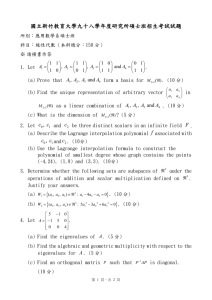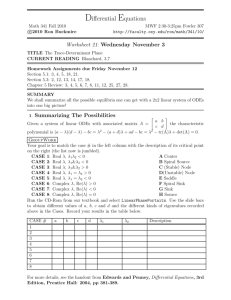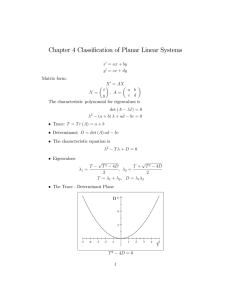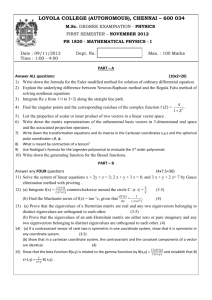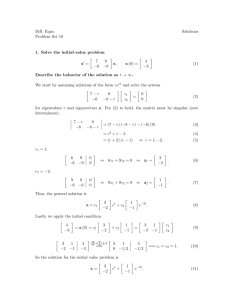Quadratic Forms
advertisement
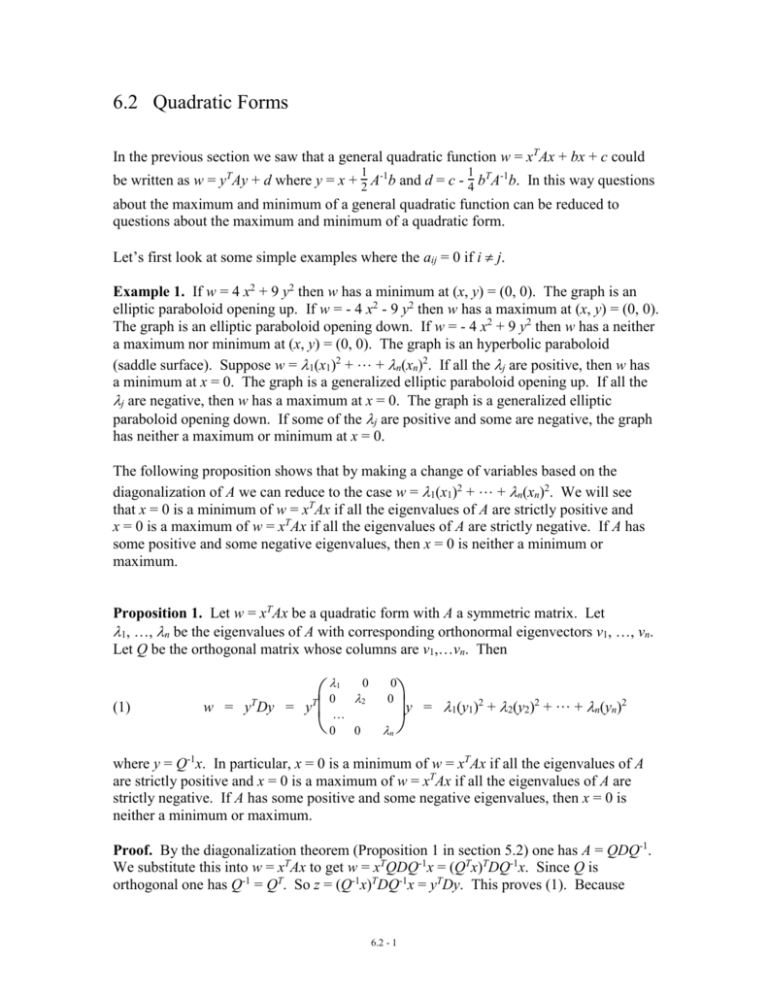
6.2 Quadratic Forms In the previous section we saw that a general quadratic function w = xTAx + bx + c could 1 1 be written as w = yTAy + d where y = x + 2 A-1b and d = c - 4 bTA-1b. In this way questions about the maximum and minimum of a general quadratic function can be reduced to questions about the maximum and minimum of a quadratic form. Let’s first look at some simple examples where the aij = 0 if i j. Example 1. If w = 4 x2 + 9 y2 then w has a minimum at (x, y) = (0, 0). The graph is an elliptic paraboloid opening up. If w = - 4 x2 - 9 y2 then w has a maximum at (x, y) = (0, 0). The graph is an elliptic paraboloid opening down. If w = - 4 x2 + 9 y2 then w has a neither a maximum nor minimum at (x, y) = (0, 0). The graph is an hyperbolic paraboloid (saddle surface). Suppose w = 1(x1)2 + … + n(xn)2. If all the j are positive, then w has a minimum at x = 0. The graph is a generalized elliptic paraboloid opening up. If all the j are negative, then w has a maximum at x = 0. The graph is a generalized elliptic paraboloid opening down. If some of the j are positive and some are negative, the graph has neither a maximum or minimum at x = 0. The following proposition shows that by making a change of variables based on the diagonalization of A we can reduce to the case w = 1(x1)2 + … + n(xn)2. We will see that x = 0 is a minimum of w = xTAx if all the eigenvalues of A are strictly positive and x = 0 is a maximum of w = xTAx if all the eigenvalues of A are strictly negative. If A has some positive and some negative eigenvalues, then x = 0 is neither a minimum or maximum. Proposition 1. Let w = xTAx be a quadratic form with A a symmetric matrix. Let 1, …, n be the eigenvalues of A with corresponding orthonormal eigenvectors v1, …, vn. Let Q be the orthogonal matrix whose columns are v1,…vn. Then 1 (1) w = yTDy = 0 yT 0 0 2 0 0 0 n y = 1(y1)2 + 2(y2)2 + … + n(yn)2 where y = Q-1x. In particular, x = 0 is a minimum of w = xTAx if all the eigenvalues of A are strictly positive and x = 0 is a maximum of w = xTAx if all the eigenvalues of A are strictly negative. If A has some positive and some negative eigenvalues, then x = 0 is neither a minimum or maximum. Proof. By the diagonalization theorem (Proposition 1 in section 5.2) one has A = QDQ-1. We substitute this into w = xTAx to get w = xTQDQ-1x = (QTx)TDQ-1x. Since Q is orthogonal one has Q-1 = QT. So z = (Q-1x)TDQ-1x = yTDy. This proves (1). Because 6.2 - 1 y = Q-1x, it follows that x = 0 is a minimum for w = xTAx if and only if y = 0 is a minimum for y = 1(y1)2 + … + n(yn)2 and similarly for a maximum. However, it is easy to see that y = 0 is a minimum for w = 1(y1)2 + … + n(yn)2 if and only if all the j are positive and y = 0 is a maximum for w = 1(y1)2 + … + n(yn)2 if and only if all the j are negative. If some of the j are positive and some are negative then y = 0 is neither a minimum or maximum. // Remark 1. If we choose a new coordinate system for x1, …, xn space with the y1 axis through v1, the y2 axis through v2, … and the yn axis through vn, then in this new coordinate system the function equation w = xTAx becomes w = 1(y1)2 + … + n(yn)2. In particular, (1) The level hypersurfaces xTAx = k becomes the level curve 1(y1)2 + … + n(yn)2 = k in the y1y2…yn coordinate system. These are generalized ellipsoids if all the eigenvalues are strictly positive or all the eigenvalues are strictly negative. These are generalized hyperboloids if some of the eigenvalues are strictly positive and the rest are strictly negative. (2) If all the j positive the graph of w = xTAx is a generalized elliptic parabolid opening up with its vertex at the origin. If all the j are negative the graph is an generalized elliptic paraboloid opening down with its vertex at the origin. If some j are positive and some j are negative the graph is a generalized hyperbolic paraboloid that opens up along the axes of the positive eigenvalues and opens down along the axes of the negative eigenvalues. These things are easiest to see with a quadratic function of two variables. Example 2. Consider the quadratic form w = 17x2 - 12xy + 8y2 = (x, y) - 6 uTAu. (a) Find the new coordinate axes (call them r and s axes) so that in the new coordinate system one has w = ar2 + bs2. Also find a and b. (b) What kind of surface is the graph of z = 17x2 - 12xy + 8y2. (c) Sketch the graph of z = 17x2 12xy + 8y2. (d) Sketch the level curve 17x2 12xy + 8y2 = 20. 17 - 6 x 8 y= (a) The new coordinate axes are along the eigenvectors 17 - 6 of A = - 6 8 . In example 3 in section 5.7 the eigenvalues of Q are 1 = 5 and 2 = 20 and the 1 -2 eigenvectors are v1 = 2 and v2 = 1 . Let the r and s axes be the lines through v1 and v2. In this new coordinate system one has w = 5r2 + 20s2. (b) The graph is a elliptic hyperboloid opening up. (c) The graph is at 2 1 2 1 1 1 2 6.2 - 2 2 the right above. (d) The level curve 17x2 - 12xy + 8y2 = 20 becomes 5r2 + 20s2 = 20 in the rs coordinate system. This is r2 + 4s2 = 4. It is an ellipse and its graph is at the right. 6 -2 x Problem 1. Consider the quadratic form z = 6x2 – 4xy + 3y2 = (x, y) - 2 3 y = uTQu. (a) Find a new coordinate system for the xy plane such that in this new coordinate system the graph of r x the function z = 6x2 - 4xy + 3y2 has the form z = Ar2 + Bs2 where s are the coordinates of y relative to this new coordinate system. Specify this new coordinate system by giving vectors along the new coordinate axes. Also, give A and B and the angle which the r axis makes with respect to the x axis. (b) Sketch the graph of z = 6x2 – 4xy + 3y2. What kind of surface is it. (c) Sketch the level curve 6x2 – 4xy + 3y2 = 98 showing relevant lengths. What kind of curve is it. 1 -2 Answers: The r axis is through v1 = 2 and the s axis is through v2 = 1 . In this new coordinate system the function z = 6x2 – 4xy + 3y2 becomes z = 2r2 + 7s2. The angle between the r axis and x axis is tan-1(2) 1.11 radians 63.4. The graph of z = 6x2 – 4xy + 3y2 is a elliptic paraboloid. The level curve 6x2 – 4xy + 3y2 = 98 is 2r2 + 7s2 = 98 in the rs coordinate system. It is an ellipse whose axis goes from – 7 to 7 on the r axis and - 14 to 14 on the s axis. 5 3 x Example 3. Consider the quadratic form z = 5x2 + 6xy - 3y2 = (x, y) 3 - 3 y = uTQu. (a) Sketch the level curve 5x2 + 6xy - 3y2 = 24. (b) What kind of surface is the graph of z = 5x2 + 6xy - 3y2. (c) Sketch the graph of z = 5x2 + 6xy - 3y2. 6 First, find the eigenvalues and eigenvectors of Q. One has 0 = det( Q - I ) = | 5- 3 3 -3- | 4 = (5 - )(- 3 - ) – 9 = - 2 - 24 = ( - 6)( + 4). So the eigenvalues are x 1 = 6 and 2 = - 4. An eigenvector v = y for 1 = 6 0 -1 3x satisfies 0 = (A - 6I)v = 3 - 9 y . So - x + 3y = 0 and 3x - 9y = 0. The solution to both 3 equations is x = 3y, so v1 = 1 is an eigenvector for 2 2 6 4 2 2 r2 system. This is 22 - ( s2 6)2 = 1. It is a hyperbola opening up the r axis with its vertices at – 2 and 2 on the r axis and 6.2 - 3 6 2 4 6 1 = 6. Since the eigenvectors are orthogonal an eigenvector for 2 = -4 is v2 = the r and s axes be the lines through v1 and v2. The level curve 5x2 + 6xy - 3y2 = 24 becomes 6r2 - 4s2 = 24 in the rs coordinate 4 -3 1 . Let asymptotes s = 6r/2 and s = - 6r/2. Its graph is below. The graph of z = 5x2 + 6xy 3y2 is an hyperbolic paraboloic opening up along the r axis and opening down along the s axis and its graph is also at the right. Example 4. Consider the quadratic equation w = 17x2 - 12xy + 8y2 - 10x - 20y + 15 17 - 6 x x = (x, y) - 6 8 y + (- 10, - 20) y + 15 = uTAu + pu + 15 (a) Sketch the level curve 17x2 - 12xy + 8y2 - 10x - 20y + 15 = 10. (b) What kind of surface is the graph of w = 17x2 - 12xy + 8y2 - 10x - 20y + 15. (c) Sketch the graph of w = 17x2 - 12xy + 8y2 - 10x - 20y + 15. x 10 In Example 4 of the previous section we saw that w = vTAv - 10 where v = y - 20. 1 In Example 1 we saw that if we choose the r and s axes be the lines through v1 = 2 and -2 v2 = 1 , then in this new coordinate system one has vTAv = 5r2 + 20s2. So, for x 1 w = uTAu + pu + 15 the rs coordinate system the has origin at y = 2 and axes parallel to the x and y axes. In this coordinate system w = 5r2 + 20s2 - 10 and the level curve w = 10 becomes 17r2 – 12rs + 8s2 = 20. So we take the level curve 17x2 - 12xy + 8y2 = 20 that we made in Example 5 and move it to the right one unit and up two units. So the 1 level curve is an ellipse with center at 2 and it is shown below. The graph z = 17x2 - 12xy + 8y2 - 10x - 20y + 15 is an elliptic paraboloid. To make it we take the graph of z = that we made in Example 5 and move it one unit in the x direction, 2 units in the y direction and – 10 units in the z direction. It is also shown below. 4 3 2 1 1 1 2 3 1 6.2 - 4 There is a local version of Proposition 1 for general non-linear functions. Proposition 2. Suppose w = f(x1, … xn) has two continuous derivatives and suppose at the point x0 one has w = 0 xj (2) for j = 1, 2, …, n. 2w Let aij = x x evaluated at x0 and A is the matrix whose components are the aij. If all the i j eigenvalues of A are strictly positive then f has a local minimum at x0. If all the eigenvalues of A are strictly negative then f has a local maximum at x0. If some of the eigenvalues are strictly positive an some are strictly negative, then f has neither a maximum or minimum at x0. w w Example 5. Let w = x2y2 - 5x2 - 8xy - 5y2. Find the places where x = 0 and y = 0 and use the second derivative test to determine if they are local minima, local maxima or neither. w w w w One has x = 2xy2 - 10x - 8y and y = 2x2y - 8x - 10y. So x = 0 and y = 0 implies xy2 - 5x - 4y = 0 and x2y - 4x - 5y = 0. We multiply the first equation by x and the second equation by y to get x2y2 - 5x2 - 4xy = 0 and x2y2 - 4xy - 5y2 = 0. Subtracting one equation from the other we get 5x2 - 5y2 = 0. So y = x or y = - x. If y = x then from xy2 - 5x - 4y = 0 we get x3 - 9x = 0 which implies x = 0 or x = 3 or x = - 3. This gives the three solutions (x, y) = (0, 0) or (x, y) = (3, 3) or (x, y) = (- 3, - 3). On the other hand, if y = - x then from xy2 - 5x - 4y = 0 we get x3 - x = 0 which implies x = 0 or x = 1 or x = - 1. This gives two more solutions (x, y) = (1, -1) or (x, y) = (- 1, 1). 2w 2w 2w One has x2 = 2y2 - 10 and yx = 4xy - 8 and y2 = 2x2 - 10. 2w 2w 2w Let’s check the point (x, y) = (0, 0). One has x2 = - 10 and yx = - 8 and y2 = - 10, so -8 - 10 - - 10 - 8 A = - 8 - 10. We need to find the eigenvalues of A. One has 0 = - 10 - -8 = (- 10 - )2 - 64. So (- 10 - )2 = 64 or + 10 = 8. So 1 = - 2 and 2 = -18. Both eigenvalues are negative, so (0, 0) is a local maximum. 6.2 - 5
